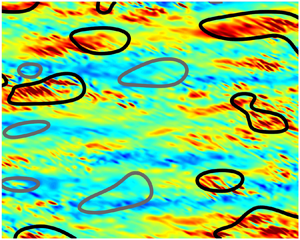Article contents
Statistical analysis of outer large-scale/inner-layer interactions in channel flow subjected to oscillatory drag-reducing wall motion using a multiple-variable joint-probability-density function methodology
Published online by Cambridge University Press: 27 July 2021
Abstract

Full flow-field data derived from a direct numerical simulation for channel flow subjected to drag-reducing oscillatory spanwise motion are analysed by means of a recently developed methodology, which consolidates the entire simulation data set within multiple-variable joint-probability-density functions (PDFs). A wide variety of statistical data of interest are then extracted from the joint PDF without recourse to any of the original simulation data. The nominal friction Reynolds number of the baseline (unactuated) flow is 1025, and the actuation is effected at a wall-scaled period of 100, at which value the drag-reduction level is approximately 30 %, while any actuation-induced phase fluctuations in the streamwise direction are minimal. Interest focuses on the elucidation of the mechanisms by which the near-wall turbulence is modified by the action of footprints of large-scale structures in the outer parts of the log-law region, which tend to intensify as the Reynolds number rises. To elucidate these mechanisms, the Reynolds stresses and their production rates, conditional on the intensity of large-scale skin-friction fluctuations, are examined. The investigation includes a separation of the Reynolds stresses into large-scale and small-scale components by means the empirical mode decomposition, allowing the intensity of footprinting and of small-scale modulation of the near-wall turbulence to be quantified separately. The conditional statistical properties are presented in the form of maps in planes having the wall-normal distance and large-scale skin friction as coordinates, supplemented by wall-normal property profiles and an examination of large-scale and small-scale contributions to the skin friction. The analysis highlights the strongly asymmetric response of the production rate and the turbulence level in the buffer layer to positive vs. negative footprints, the former strongly enhancing small-scale turbulence. This is proposed to be at least a partial explanation of the decline in the drag-reduction effectiveness of oscillatory spanwise wall motion with increasing Reynolds number.
JFM classification
Information
- Type
- JFM Papers
- Information
- Copyright
- © The Author(s), 2021. Published by Cambridge University Press
References
REFERENCES
- 5
- Cited by


